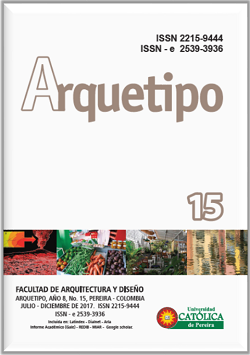Oscar Niemeyer: typological and morphological essays on the architecture of free forms
DOI:
https://doi.org/10.31908/22159444.3678Keywords:
Modern movement, Tropical architecture, Brazil, nature-artifice concatenationAbstract
The article analyzes some works by Oscar Niemeyer, selected for their plastic and conceptual innovation, and proposes a classification of these according to three different characteristics:
the first group brings together some projects whose genesis is developed from the definition of the plant, or the section; the third type is an overlap of the first two:
the design is born from the spatial fusion between planimetric and elevation footprint, and tries to give life to a new organic, four-dimensional space that recalls recent experiments in contemporary architecture.
It shows how the Carioca’s research was ahead of its time being - as the historians Kennet Frampton and Roberto Segre, and the architects Norman Foster and Iñaki Ábalos, among others - one of the most important influences for the second generation of the architects of the Modern movement.
References
Bullaro, L. (2014). Moderno y tropical: la reinterpretación de los principios lecorbuserianos en las primeras obras de Oscar Niemeyer, en DeArq núm. 15, diciembre 2014. Bogotá, Universidad de Los Andes. Pp. 36-51.
Bullaro, L. (2016). Brasil Holistico, ponencia publicada en XI DO.CO. MO.MO. Brasil, Recife:seminario2016.docomomo.org.br/artigos_apresentacao/sessao% 06/DOCO_PE_S6_BULLARO.pdf.
Dias Comas, C. (2009). Oscar Niemeyer, Cem anos de solidão, en SEGRE, Roberto, Tributo a Niemeyer, Rio de Janeiro: Viana. Pp. 128-139.
Dias Comas, C. (2012), Feira Mundial de Nova York de 1939: O Pavilhão Brasileiro, en Arqtexto n.16, Porto Alegre: UFRGS ed. Pp. 15-18.
Frampton, K. (2009). Homenagem a Niemeyer. En Segre, Roberto, Tributo a Niemeyer, Rio de Janeiro: Viana. Pp. 26,27.
Hadid, Zaha (2015), “Niemeyer tenía un talento innato para la sensualidad. La proyectista destaca entre sus obras predilectas el hogar que se construyó en Río de Janeiro el arquitecto brasileño”, en El Pais, 31 junio 2015, Madrid. Disponible en: https://elpais.com/elpais/2015/07/30/eps/1438277654_359244.html.
Haeckel, E. (1904), Kunstformen der Natur, disponible en: http://caliban.mpizkoeln.mpg.de/haeckel/kunstformen/Haeckel_Kunstformen.pdf
Le Corbusier (1995), A word to my friends in Brasil, en OEuvre Complete, 1910-1969, vol. VI Basilea: Birkhäuser Verlag, p. 8.
Martí Arís, C. (1993). Las variaciones de la identidad. Ensayo sobre el tipo en arquitectura. Barcelona: Ediciones del Serbal. Pp.11-25.
Moneo, R. (2004), Inquietud teórica y estrategia proyectuales Barcelona: Actar. Pp. 14-22
Niemeyer, O. (1995), Le Corbusier, en LE CORBUSIER, OEuvre Complete, 1910-1969, vol. VI. Basilea: Birkhäuser Verlag, p. 9.
Niemeyer, O. (2004). “Minha aquitetura” Rio de Janeiro: Revan. p. 55.
Nouvel, J. Museo de la evolución humana, Burgos, España. Página web consultada el 30 septiembre 2017. Disponible en http://www.jeannouvel.com
Papadaki, S. (1950). Oscar Niemeyer, The Work of Oscar Niemeyer, New York: Reinhold Publishing Corporation. pp. 104-107.
Sanaa, Kazuyo Sejima, Ryue Nishizawa (2012). Madrid: El Croquis Ed.
Segre, R. (2008), Oscar Niemeyer: 100 Anos, 100 Obras, Sao Paulo: Insituto Tomie Ohtake. Pp 9-13.
Segre, R. (2012), Oscar Niemeyer, tipologias e libertades plasticas en SEGRE, Roberto, Tributo a Niemeyer, Rio de Janeiro: Viana. Pp.162-175.
Underwood, D. (1994). Oscar Niemeyer and the architecture of Brazil. New York: Rizzoli.
Zevi, B. (1997). Storia e controstoria dell’architettura. Roma: Newton, p. 715.
Zevi, B. (1982). Storia dell’architettura moderna. Bologna: Zanichelli. p. 320.

